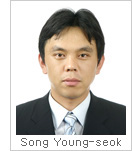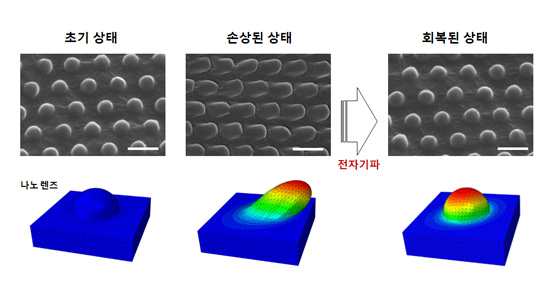He solved the durability issue of the structures which was a problematic subject in Nano-material Engineering, posting the results in the November issue of Scientific Reports

Professor Song Young-seok’s research team (Department of Fiber System Engineering) has developed a technology that can revolutionarily improve the durability of nanostructures, which was a problematic subject in Nano-material Engineering
Professor Song’s research team has developed a nanostructure that can retrieve its original shape through an electronic wave using carbon nano-material and a shape memory polymer. This result was posted in the internet version of the November issue of Scientific Reports, a sister scholarly paper of the national academic journal, Nature.
Although nanotechnology has endless possibilities and it has been used in very limited areas in daily life such as semiconductors. Its use was very limited because its durability was not guaranteed since produced nano-patterns were easily damaged even by a small external shock. Therefore, the nanostructure’s durability was an unsolved problem in nanotechnology.
Professor Song’s team solved the durability problem of nanostructures with smart materials such as shape memory material and self recovering material. Through this, nano-engineering is expected to be used more widely in various areas such as various types of displays including cell phones and TVs, smart systems including sensors and actuators, and surface engineering including coating.
They produced a nano-lens that can be applied in optical science areas and analyzed various optical and surface characteristics. Also, existing smart materials were able to recover their shape by heating from the external source, but in this research, a new shape recovery mechanism was developed by charging electromagnetic waves absorbing carbon nanomaterial (fullerene) on nano-lenses.
This allows the structure to be easily recovered by giving an external electromagnetic wave in case the nano-lens structure formed on the surface of a cell phone or LED is damaged. Furthermore, added fullerene was proven to absorb electronic waves and revolutionarily increase the mechanical strength of the nano-lens.

Professor Song said “through this research, I am expecting to expedite the date that nano-engineering will be used in our daily lives as the team secured the long term durability of nanostructures in various areas.”
Meanwhile, Song Young-Seok’s research team has found an essential phenomenon with micro-fluid that can be used to develop a portable blood analyzer or high tech cell analyzer that was developed from joint research with Seoul National University’s team (Professor Yoon Jae-Ryun). This research is expected to be applied in labs on chip technology that allows individuals to easily check their own health status by processing a simple blood assessment with their smart phone at home or work. Such results were posted in the same journal simultaneously.